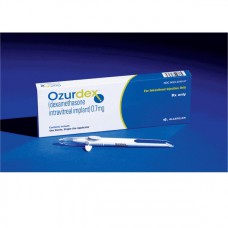Expiration date: 03/2026
Pharmacodynamics. Dexamethasone is a powerful corticosteroid, which has a pronounced anti-inflammatory effect and reduces the formation of edema by reducing fibrin deposition, capillary permeability, and phagocyte infiltration in response to inflammation. Growth factor vascular endothelial (VEGF) is a cytokine that is produced in high concentrations in the resolution of macular edema. It is a powerful stimulator of vascular permeability. It has been demonstrated that corticosteroids inhibit the expression of growth factor vascular endothelium. Additionally, corticosteroids prevent the release of prostaglandins that have been identified as mediators katodnogo macular edema.
Treatment with the Ozurdex implant a significant number of patients have improved visual acuity with the maximum correction ?15 characters 90 days after injection of a single implant compared with the original data.
The therapeutic effect observed in the first observation point at the 30th day (or 21.3% of patients). The maximum effect of treatment was observed on the 60th day (29.3% of patients) and remains positive throughout the entire time up to the 90th day after injection (21.5% of the patients). Tendency of improvement in visual acuity with the maximum correction ?15 characters, after application of the implant Ozurdex, stable on the 180th day (21.5% of the patients).
During clinical trials found that patients who received treatment with the Ozurdex implant, achieved the following results in comparison with patients who did not receive treatment with implant:
- the average change in visual acuity with the maximum correction in comparison with baseline was significantly greater during all observations,
- patients achieve improved visual acuity in the 3rd line with a maximum correction of earlier than others
- effectiveness in preventing loss of vision,
- a significant decrease in the retinal thickness and a significant reduction from baseline in 90-day. The therapeutic effect confirmed by the evaluation of the improvement of visual acuity, due to this anatomical change. To 180-day average reduction in the thickness of the retina is not significant.
The results of treatment in each time interval are always better after the second treatment, in comparison with the first. Delaying the second injection at 6 months leads to a deterioration of results of treatment during all observations.
Pharmacokinetics. Data on drug concentrations in plasma were obtained in the subgroup of 21 patients in two 6 month studies prior to the effectiveness of dosing to 7, 30, 60 and 90-th day after injection of the intravitreal implant containing 350 or 700 µg dexamethasone. 95% of the concentration of dexamethasone in blood plasma for the group with the dosage of 350 µg and 86% for the group with dosing of 700 µg was below the limit of quantification (0.05 ng/ml). Cmax in blood plasma 0,094 ng/ml was observed in 1 patient of the group with dosage of 700 mg. It turned out that the concentration of dexamethasone in blood plasma does not depend on age, body weight or sex of the patient.
6-month animal study after a single intravitreal injection of ozurdex implant, the average Cmax of dexamethasone in the vitreous body of the eye was 100 ng/ml on the 42nd day after injection and 5.57 ng/ml on the 91st day. Dexamethasone was determined in the vitreous body after 6 months after injection. The rank order of the concentration of dexamethasone was as follows: retin-a>,the iris is the>ciliary body>vitreous humour>,intraocular fluid,the blood plasma.
In the study of metabolism in vitro after 18 h of incubation of 14C-dexamethasone with human cornea, iris, ciliary body, choroid, retina, vitreous body and sclera tissues of the metabolites of the drug were observed. These results coincide with the results of studies of the metabolism of the eyes of animals.
Dexamethasone is metabolized to the final fat and water - soluble derivatives that are excreted in the bile and urine.
The Ozurdex matrix slowly degraded to lactic and glycolic acid through simple hydrolysis, then to carbon dioxide and water.
INDICATIONS:
treatment of adult patients with macular edema, which occurred due to occlusion of the Central retinal vein or occlusion branch retinal vein.
APPLICATION:
The ozurdex can enter only a qualified ophthalmologist, who has experience of the introduction of intravitreal injections.
Implant for intravitreal injection in the applicator is for single use is intended solely for intravitreal use.
Each applicator can be used for the treatment of only one eye.
The intravitreal injection procedure should be carried out only under aseptic conditions, including use of sterile gloves, sterile wipes and sterile extender for age (or equivalent).
Prior to injection or on the day of the procedure should be applied topically antibacterial drug broad-spectrum. Need to apply adequate local anesthesia.
You need to remove the foil pouch from the carton and check that it has not been damaged. Then, in sterile conditions, open the foil pouch and gently place the applicator on a sterile tray. Carefully remove the cap from the applicator.
To use the applicator immediately after opening the foil pouch.
Holding the applicator in one hand and need to extract the fuse from the applicator. Do not twist and do not bend the fuse. Bringing cut needle applicator directly to the sclera to insert the needle about 1 mm into the sclera then redirect the applicator in the direction of the center of the eye in the vitreous cavity until the silicone sleeve will be opposite of the conjunctiva. Slowly depress the drive button until it clicks. Before removing the applicator from the eye to make sure that the actuator button is fully pressed and blocked the outflow of liquid from the surface applicator. Withdraw the needle from the vitreous body in the opposite direction, which is used for the introduction.
Immediately after the introduction of the Ozurdex implant is necessary to hold indirect ophthalmoscopy in the sector of injection to confirm successful implantation. Visualization is possible in the majority of cases. In cases where the implant cannot be visualized, you need a sterile cotton swab to lightly press in the injection to make the implant visible.
After intravitreal injection patients should continue taking antibiotics broad spectrum.
Recommended dose: one Ozurdex implant is injected intravitreally in the affected eye. It is not recommended to use simultaneously for both eyes.
Repeated doses may be used when the patient appears the response to treatment, which is accompanied by further loss of visual acuity and, according to the doctor, re-treatment may be in the beginning, will improve the condition of no significant risk for the patient.
Patients eyes that are improved and saved, it is not necessary to repeat therapy. Patients who experience vision deterioration, which is not slowing down after using the implant Ozurdex, should not be subjected to re-treatment.
Elderly patients (over 65 years) dose adjustment is not required.
CONTRAINDICATIONS:
hypersensitivity to the active substance or to any of the excipients of the drug. Or potential acute ocular or periocular infection including most viral diseases of the cornea and conjunctiva, including active epithelial herpes keratitis (tree-like keratitis), serum sickness, varicella, mycobacterial infections and fungal diseases.
Developed glaucoma (with the lack of effectiveness of drug therapy).


